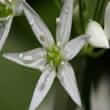Background
- Bear's garlic, so named because brown bears in Europe tend to feast upon it, is a wild relative of the chive that is popularly used as a flavoring or dietary vegetable in Central European cuisine. It grows in swampy fields and wooded areas in slightly acidic soil and is often picked as a vegetable for salads or steamed dishes by people who live in indigenous areas.
- Bear's garlic has been confused with lily of the valley and autumn crocus, especially in the spring before flowering. Several cases of colchicine poisoning due to consumption of autumn crocus mistaken for bear's garlic have been reported in recent years. Colchine is a highly poisonous alkaloid that can lead to gastroenterocolitis, followed by multiple organ failure, and sometimes death.
- Although there is a lack of human evidence describing the use of bear's garlic for any indication, bear's garlic may have inhibitory effects on human platelet aggregation. Bear's garlic is not listed on the U.S. Food and Drug Administration's (FDA) Generally Recommended as Safe (GRAS) list.
References
Natural Standard developed the above evidence-based information based on a thorough systematic review of the available scientific articles. For comprehensive information about alternative and complementary therapies on the professional level, go to . Selected references are listed below.
- Brvar M, Kozelj G, Mozina M, et al. Acute poisoning with autumn crocus (Colchicum autumnale L.). Wien.Klin Wochenschr. 3-31-2004;116(5-6):205-208.
View Abstract - Carotenuto A, De Feo V, Fattorusso E, et al. The flavonoids of Allium ursinum. Phytochemistry 1996;41(2):531-536.
View Abstract - Gabrscek L, Lesnicar G, Krivec B, et al. Accidental poisoning with autumn crocus. J Toxicol Clin Toxicol 2004;42(1):85-88.
View Abstract - Hermanns-Clausen M, Schindler F, Stedtler U, et al. [Poisoning by the autumn crocus plant]. MMW Fortschr Med 3-23-2006;148(12):45-47.
View Abstract - Klintschar M, Beham-Schmidt C, Radner H, et al. Colchicine poisoning by accidental ingestion of meadow saffron (Colchicum autumnale): pathological and medicolegal aspects. Forensic Sci Int 12-20-1999;106(3):191-200.
View Abstract - Sendl A, Elbl G, Steinke B, et al. Comparative pharmacological investigations of Allium ursinum and Allium sativum. Planta Med. 1992;58(1):1-7.
View Abstract - Smeets K, Van Damme EJ, Van Leuven F, et al. Isolation, characterization and molecular cloning of a leaf-specific lectin from ramsons (Allium ursinum L.). Plant Mol.Biol 1997;35(4):531-535.
View Abstract - Stern N, Kupferschmidt H, Meier-Abt PJ. [Follow-up and therapy of acute colchicine poisoning]. Schweiz.Rundsch.Med Prax. 5-28-1997;86(22):952-956.
View Abstract - Sundov Z, Nincevic Z, Definis-Gojanovic M, et al. Fatal colchicine poisoning by accidental ingestion of meadow saffron-case report. Forensic Sci Int 5-10-2005;149(2-3):253-256.
View Abstract







